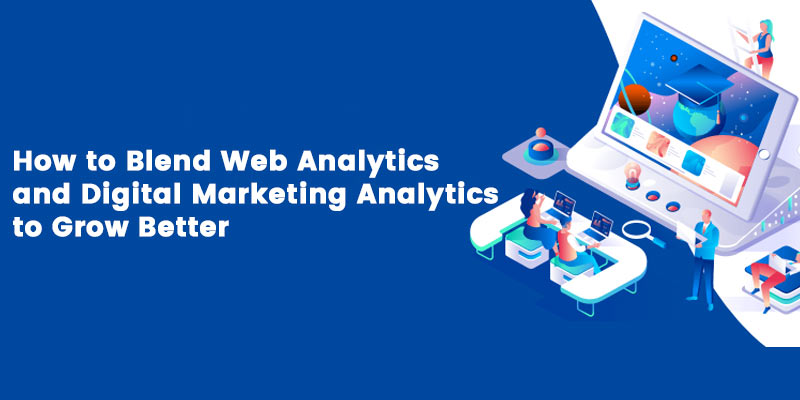The organization faces the challenge of measuring the effectiveness of Digital marketing. The digital marketing manager must have good analytical skills to run successful digital marketing campaigns. You might have heard the word digital analytics as a digital marketing manager, Marketing analytics is not just a single term; it comprises various strategies and techniques, such as web-based metrics typically associated with familiar analytics like Google Analytics, which analyzes traffic, bounce rate, and site visitors.
To learn more about the web analytics, you can join Digital Marketing Course in Chennai, which will help you have a better understanding of SMS Marketing, YouTube Optimization, Social Media Optimization and Social Media Marketing.
Moreover, Google analytics is just one part of digital marketing. Web analytics provides insight into your website’s performance, the impact of marketing campaigns, conversion rates and customer journey.
So, Digital marketing analytics offers a much more comprehensive view of what’s working regarding your marketing strategy. Understanding and leveraging digital marketing analytics is crucial regardless of how you fit into your company’s marketing blend. Analytics data reveals whether your marketing is effective and how and where you can improve.
This blog will discuss marketing analytics, marketing analysis tools and digital marketing metrics. Moreover, you will also learn how to read and apply them to your marketing decisions and how to leverage them to grow your business and bottom line.
If you want to begin your career as a content writer, you can join Digital Marketing Course in Chennai, which will help you understand marketing analytics in digital marketing, marketing analysis tools such as Google Analytics, MixPanel, the AdWords Performance Grader, Heap Analytics, Cyfe, etc.
What are the metrics of digital marketing
Digital marketing metrics are statistical measurements that marketers use to assess the effectiveness of various marketing initiatives in terms of the overall objectives of their campaigns and industry norms.
Let’s start by getting rid of vanity metrics. These surface-level numbers frequently deceive you into believing that your efforts are successful. They are often large numbers linked to hazy ideas like social media “impact,” and they are more fluff than facts. They may make your marketing team feel good, but they add little in the way of practical benefits for the company.
If you are interested in learning Google Ads, you can join Google Ads PPC Training in Chennai, which aids in understanding display Ads, campaign types and settings, advertising metrics, improving ROI, and creating search Ads.
Best Metrics for Website Marketing Analytics
These digital marketing metrics related to websites and online activity are listed below.
Visitor
A visitor is a person who visits your website to learn about your services and products. A monitoring code on your website lets you track visitors by placing cookies in their browsers.
Page View
A page view is defined as the number of visitors viewed the websites. Every time your tracking code is loaded, a page view is recorded.
Session
A session is a collection of actions a visitor takes while on your websites, such as page views, Call-to-Action, and activities. Inactive visitors’ sessions end after 30 minutes.
Traffic
The total number of visits to a website or page over a specific period is known as traffic.
Traffic by Channel
Traffic by channel is the maximum number of visits to a website or a specific page through each referral source (such as social media, email, landing pages, etc.).
Traffic by Device
This estimation is based on how many members visited the website or web page via devices such as desktops, smartphones and tablets.
The ratio of New Traffic to Returning Traffic
The new traffic to returning traffic ratio is the ratio of a net new site or page visitors to all previous visitors.
Time on Page
Time on page refers to how long a visitor stays on the website or how many hours or minutes the visitor spends.
Interactions per Visit
If your visitors need to convert on their first visit, it’s essential to comprehend their actions on your site. Whenever a visitor opens a new page, leaves a blog comment, or spends a lot of time looking at a particular piece of content. This crucial exchange will improve your understanding of visitor behaviour.
Bounce Rate
It is crucial in web analytics in digital marketing because the website’s bounce rate will impact significantly.
The percentage of visitors who leave your website right away after viewing a page is known as the bounce rate.
For example, if a visitor to your website’s home page arrives from a search engine or a social media post but leaves without clicking.
Lead Generation
To increase future sales, the process of attracting potential customers’ interest is known as lead generation. It is an essential step in many businesses’ sales processes.
Call-to-Action (CTA) Click-Through Rate
The ratio of overall CTA clicks to an overall page, or site visits are known as the CTA click-through rate.
Submissions
The number of people who completed and are required to submit your web form is known as the submission rate.
Conversion Rate
The conversion rate is the ratio of visits to actions (such as downloads or sign-ups) made in response to your lead magnet.
Free Trial Conversion Rate
The proportion of free trial users who became paying customers is known as the free trial conversion rate.
Pop-Up Conversions
The percentage of completed pop-up forms that resulted in sales is known as pop-up conversions.
The ratio of Generated Leads to Marketing-Qualified Leads (MQL)
The quantity of “good fit” leads obtained from your lead magnet as a percentage of all leads generated is the ratio of generated leads to MQL.
Leads to Close Ratio
The percentage of leads converted into customers compared to the total number of leads is known as the leads-to-close ratio.
To have a profound understanding of digital marketing, you can join Digital Marketing Course in Chennai and marketing analytics is important, web analytics in digital marketing, setting up of websites using WordPress, lead Generation and managing CRM.
Best Metrics for Email Marketing
These digital marketing metrics related to email marketing are listed below.
Open Rate
The open rate is the proportion of emails that were opened out of all emails sent.
Opens by Device
The number of total emails opened by type of device is known as “opens by the device” (e.g., smartphone, tablet, and desktop).
Click-Through Rate
The percentage of all clicks on an email link, or CTA, compared to all email opens is known as the click-through rate.
Bounce Rate
The bounce rate is the proportion of emails that are not delivered out of all emails sent.
Unsubscribe Rate
The number of individuals who unsubscribe from your email list within a specific time frame is known as the unsubscribe rate.
Digital Marketing Course in Bangalore meticulously designed the course for the Bangalore- based students who intended to learn the nuances of digital marketing concepts such as marketing analytics, SEO Tools, Blog Marketing, Content Marketing, Making a Competitor Analysis, Website Audit, etc.
Best Metrics for Social Media
These digital marketing metrics related to social media and content are listed below.
Engagement Rate
The interaction rate is the total number of all interactions (such as comments, clicks, and likes) as a percentage of all page or post views.
Follows and Subscribes
Your followers and subscribers represent the total number of people who have expressed interest in your content and have signed up to receive notifications when new posts or articles are published.
Shares
The term “shares” refers to the total number of times a post or page has been shared via social media, a website, or a blog.
Audience Growth Rate
This is an expression of the rate at which your social audience has grown over time. To calculate it, count the number of new social media followers you’ve gained during a specific period (like two weeks or a month), divide that number by the total number of followers you have, and then multiply the result by 100.
Post Reach
Your brand will profit more from social media posts that go viral. Platforms for digital marketing analytics can show you how many of your social media followers have seen your most recent post. To calculate your post reach percentage, divide your followers by 100 again.
Potential Post Reach
It’s also important to consider how far your posts might spread.
To calculate this metric, divide the total number of times your brand has been mentioned by the number of fans the person or company has. Your “theoretical reach,” or the number of people you can theoretically reach using your current network, is the outcome. Usually, two to five per cent of this amount is the potential reach.
Approval Rate
Finding out how many of your posts have received positive responses from followers is the aim of approval rate measurement. These can help you determine whether your marketing campaign is succeeding. They may include likes, shares, reshares, or even sales conversions.
If you are interested in taking a digital marketing course, you can join Digital Marketing Courses in Bangalore and learn from the fundamental to advanced core concepts of Digital marketing.
How Digital Marketing Analytics Connects Every Business Activity
Digital marketing analytics is the core concept of digital marketing and it must be understood clearly. Using digital marketing analytics enables marketers to assess the relative performance of each of their promotional campaigns – social media vs. blogging vs. email marketing), as well as the true ROI of their efforts, and gauge the degree to which they succeed in their corporate objectives.
Marketers can identify weaknesses in particular channels in their marketing strategy and adjust strategies and techniques to improve their overall marketing activity. They can gather from full-stack digital marketing analytics.
You can join Google Ads PPC Training in Chennai, which will help you understand AdWords Tools Branding Goals, Bid methods and Bid modifiers, AdWords display advertising, account structure and contextual targeting.
In web analytics tools, you can spend hours segmenting and dicing data to compare new vs. repeat visitors month over month. But finally, you will need a thorough analysis of your marketing effectiveness.
Marketers are well aware of the limitations in their ability to assess the success of their efforts; this blog explains how full-stack digital marketing analytics addresses those limitations.
The first step in creating a solid digital marketing analytics strategy is to conduct a digital marketing analysis. By this method, a business goal can be divided into three main categories of outcomes:
- The relationship between different marketing channels
- People-centric data on the buyer’s journey
- Revenue attributed to specific marketing efforts
Now that you have understood marketing analytics, metrics of digital marketing and what is web analytics in digital marketing. So, to learn more about digital marketing, you can join Digital Marketing Courses in Bangalore, which will help you understand web analytics in digital marketing, campaigning goals, and traditional marketing versus digital marketing.





